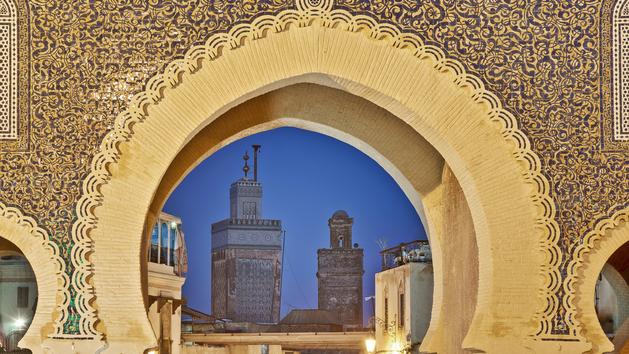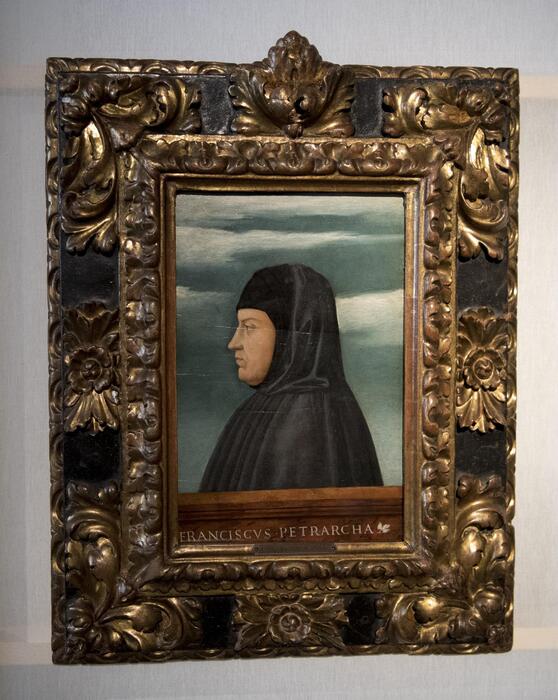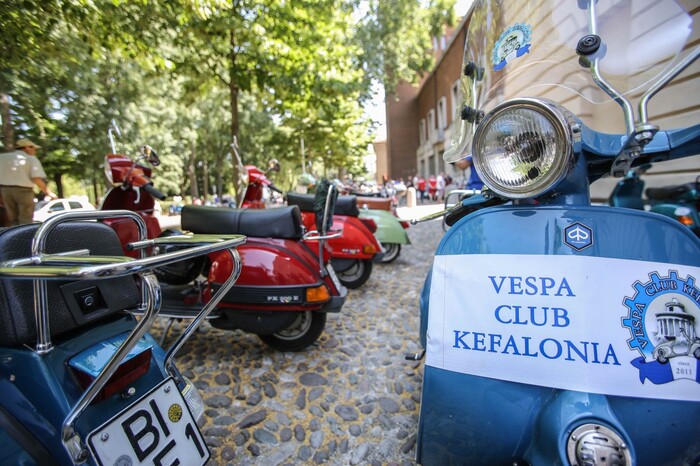From madrasahs to illustrious mosques, from mausoleums to sumptuous palaces: a journey through the imperial cities delves into a rich history spanning more than thirteen centuries.
Since the creation of the first kingdom of Morocco in 789, several dynasties have succeeded at the head of the country: Idrissides, Almoravids, Almohades, Mérinides, Saadiens and Alaouites.
In turn, the sovereigns chose Fez, Marrakech, Rabat and Meknes as their capital.
Each has kept an important religious, cultural and architectural heritage.
Fez, the intellectual
Built in the 14th century, the Attarine Madrasa is one of the best preserved in Morocco.
ONMT
“The city of faith and knowledge”, “the Athens of Africa”, “the cradle of Moroccan tradition”: there is no lack of qualifiers to describe Fez.
Nestled in the mountains of the Middle Atlas, it occupies a special place in the history of the country.
Founded in 789 by Idriss I, it is the oldest imperial city and the capital of the very first kingdom of Morocco.
Today, it houses the largest medina in the country, where the essential places of his visit are located.
Bab Boujloud and the Bou Inania madrasah
With its three arches and its blue ceramic facade, Bab Boujloud will be your point of reference for exploring the old medina.
Take the Talâa Kbira to access the Bou Inania medersa.
Created in 1350 by Sultan Abu Inan, this Muslim theological university is the largest in Fez and it is the only one that non-Muslims can visit.
Admire the finesse of Marinid art, with its superb facades decorated with cedar wood, stucco and mosaics.
Open Saturday to Thursday, 9 a.m. to 6 p.m. (times subject to change due to the coronavirus epidemic).
Entrance: 10 DH (0.92 €).
The Quaraouiyine mosque and the Attarine madrasah
Founded in the 9th century by Fatima al-Fihria, daughter of a wealthy merchant from Kairouan (hence its name), the Quaraouiyine mosque is home to one of the oldest universities in the world.
Its visit is not allowed to non-Muslims, but you can access the library, which has just been restored as part of a major renovation project of the medina.
Right next door, go see the Attarine Madrasah, an architectural gem from the Marinid period.
Stop for a few minutes in front of the marble fountain in the interior courtyard and contemplate: it is considered the most beautiful in Fez.
Open daily from 9 a.m. to 6 p.m. (except prayer times).
Entrance: 20 DH (1.8 €).
Craftsmen and tanners
Craftsmen make the richness of the medina and give it its character which is still so alive.
Observe the meticulous work of each trade: the carpet weavers, the carpenters, the leatherworkers and the brassworkers of the Place Seffarine.
Do not miss one of the most emblematic crafts of Fez: the tannery.
Go see the largest, the Chouara tannery.
At the entrance, provide yourself with a few sprigs of fresh mint, this will help to reduce the very strong and often unpleasant smell.
Read also: Moroccan architecture and crafts to the rescue of Fez
Our advices :
Several shops offer access to their terrace to have a view of the Chouara tannery.
For the best view, exit the medina and go around the tannery from the back, then reenter again.
Access between 10 and 20 DH, to be negotiated.
The medina of Fez has more than 9,500 alleys.
To visit it in depth, leave the main arteries and take the time: drink a mint tea in a small stall, taste the
honey
griwechs
that adorn the pastry stalls, chat with the locals.
Finally, take a tour of the ruins of the Marinid Tombs to enjoy breathtaking views of the old town.
Marrakech, the pearl of the South
With its red walls, its alleys of palm trees and its semi-arid climate, Marrakech is the gateway to the great Moroccan South.
From its roofs, you will see the snow-capped peaks of the High Atlas, the last natural barrier before the immensities of the Sahara.
From the Almoravids in the 11th century, then under the Almohads in the 12th century, its strategic position made it the capital of a vast empire stretching from Muslim Spain to the banks of the Senegal River.
Read also: What to visit in Marrakech, from Majorelle to the Secret Garden
Jemâa El Fna square and the Koutoubia
Jemâa El Fna Square is the beating heart of the city.
Soak up the unique atmosphere of this open-air theater: drink a squeezed orange juice, taste tanjiya, the local dish, listen to storytellers and snake charmers.
To do in the late afternoon but especially at night when the activity is in full swing.
Just next door, don't miss the Koutoubia Mosque, emblem of the city with its 77-meter minaret.
It cannot be visited but you can walk in its pretty gardens.
Built in 1120 under the Almoravid dynasty, it was completed 76 years later by the Almohads and then served as a model for the Giralda in Seville.
Observe the magnificent intertwined arches that adorn the minaret.
The souks and the Ben Youssef medersa
Listed by Unesco since 1985, the Marrakech medina is one of the most beautiful in Morocco.
Leave Jemâa El Fna Square by Semmarine Street heading north to explore the different souks: jewelers, dyers, blacksmiths.
Then head to the Ben Youssef medersa, the most important Koranic school in Marrakech.
Imagine: it could accommodate up to 900 students in its 130 rooms.
Open every day from 9 a.m. to 6.30 p.m., admission: 70 DH (6.40 €).
Bahia Palace and Badii Palace
Built in the 19th century by the wealthy vizier Ba Ahmed, the Bahia Palace is an unmissable masterpiece of Moroccan art.
Open every day from 9 a.m. to 4.30 p.m., admission: 10 DH (0.92 €).
One kilometer away, see the remains of Badii Palace.
Built at the end of the 16th century, it will impress you with its ruins of immense dimensions.
Open every day from 9 a.m. to 4:45 p.m., admission: 70 DH (6.40 €).
Our advices :
Prefer the morning to visit the Ben Youssef medersa, the Bahia palace and the Badii palace, you will avoid the crowds.
Take a guide for detailed explanations.
Spend the hot hours of the day in the shaded alleys of the souks and take a fruit juice break on the charming terrace of the Café Arabe.
At the end of the day, take a walk at the Koutoubia: with the last light, the minaret takes on beautiful orange hues.
Finally, go drink a mint tea at the Café de France at sunset, you will enjoy a beautiful view of Jemâa El Fna.
Rabat, the fortress city
Less hectic than Marrakech, Rabat will be a calm and pleasant stage of your stay.
Major asset: it is the only imperial city located by the ocean.
Founded in 1150 by the Almohads for military purposes, it became an imperial city at the end of the 18th century under the reign of the Alawite sultan Mohammed III.
In 1912, General Lyautey made it the capital of Morocco when the French protectorate was established.
The Oudayas Kasbah
With its winding streets, pretty wooden doors and blue and white walls, the Oudayas Kasbah evokes the distant Mediterranean villages of Tunisia or Greece.
Perched above the Atlantic and the Bouregreg River, this military fortress built in the 12th century by the Almohads served as a starting point for their expeditions to Andalusia, hence the name of the city in Arabic "Ribat al-Fath ”(The fortress of the conquest).
The Hassan tower and the Mohammed V mausoleum
Emblem of Rabat, the Hassan Tower and its parterre of white columns are the only vestiges of the grandiose dream of the Almohad Sultan Yacoub Al-Mansour, who wanted to erect in the 12th century the largest mosque in the world.
The work stopped when he died and the 1755 earthquake ended the dream.
Next door, the mausoleum of King Mohammed V, the father of Moroccan independence.
This architectural masterpiece designed by Vietnamese architect Eric Vo Toàn also houses the royal tombs of Moulay Abdellah and King Hassan II.
Open daily from 9 a.m. to 6 p.m.
Our advices :
In the Casbah des Oudayas, the Café Maure is a mythical place to admire the view of the Bouregreg and the ramparts of the neighboring Salé.
Currently under renovation, it should reopen soon.
After the Casbah, go to the rue des Consuls, an essential pedestrian artery for traditional crafts, especially the carpet of Rabat.
To go to the Hassan Tower, you can take the tram.
In case of heat, prefer the morning or the end of the afternoon because there is not much shade.
At the end of the day, organize a trip along the ramparts.
If you are not motorized, a taxi will take you for a few dozen dirhams.
A pleasant stroll at sunset.
Meknes, the "Versailles of Morocco"
Less frequented and quieter than its neighbor Fez, Meknes conceals magnificent monuments.
They are mainly the work of a man: Moulay Ismaïl, Alawite sultan of the 17th century who decided to make it his capital.
During the 55 years of his reign, this contemporary of Louis XIV had 40-kilometer ramparts erected and many palaces, mosques and gardens built.
The imperial city
Meet in front of Bab Mansour, the most imposing gate of the imperial city with its beautiful marble columns.
Then go to the mausoleum of Moulay Ismaïl.
Created in 1703, it is one of the few in Morocco open to non-Muslims, apart from the tomb itself.
From the entrance, you will see the Comtoise clocks offered to the Sultan by Louis XIV.
Hours: 9 a.m. to 6.30 p.m., free.
Then, go see the Heri Souani, an attic where the city's food reserves were stored (9 a.m. to midday, 3 p.m. to 6:30 p.m., 10 DH / € 0.92), and the Sahrij Souani (open 24 hours a day, free ), a huge water reservoir that will be the opportunity for a pleasant walk at the start or end of the day.
The Medina
From the Al-Hedim square, located between the city and the medina, walk through the covered market, one of the most beautiful in Morocco with its stalls of spices and dried fruits.
Then go to the medersa Bou Inania, a superb Koranic school built in the 14th century under the Marinid era.
Go up to the terrace for a nice view over the rooftops.
Hours: 9 am to midday, 2 pm to 6 pm.
Price: 10 DH (0.92 €).
Our advices :
To enjoy a beautiful panorama of Al-Hedim Square and the Bab Mansour Gate, have a coffee at the Pavillon des Idrissides.
Entrance fee of 15 DH (1.4 €), drink included.
Like Fez, the Meknes medina is renowned for its craftsmanship.
Take the opportunity to shop.


/cloudfront-eu-central-1.images.arcpublishing.com/prisa/MRCVFTDVBNHVFBKXS3VWGODRAE.jpg)






